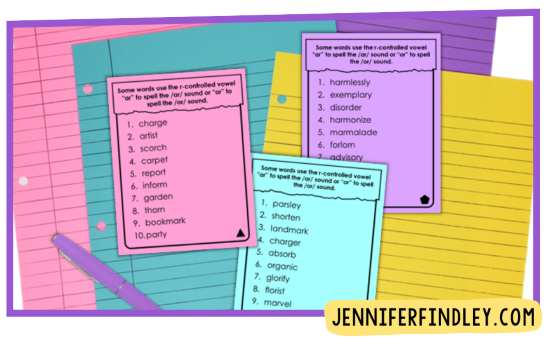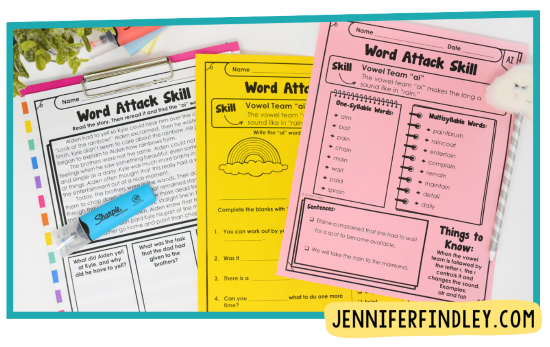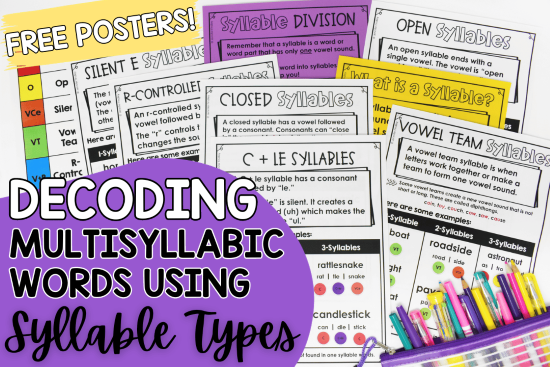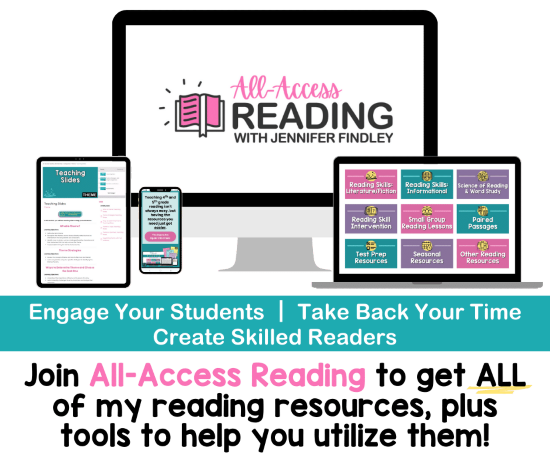When students get to 4th and 5th grade, there’s an expectation that they are reading to learn and that they have already mastered the skill of reading. However, that’s really not the case for many students …and sometimes for the majority of our students.
One issue that holds students back in reading are deficits or gaps in their phonics skills. This is especially difficult in 4th and 5th grade because students are expected to read multisyllabic words, words where the vowels flex to the schwa sound, and words with more complex patterns or irregularities. In this blog post, I will share three approaches for addressing and bridging phonics gaps with your students.

#1 – Teach Phonics Skills Through Syllable Types
Teaching syllable types is a “grown-up” approach to reteach phonics skills in the upper elementary grades and beyond. By teaching syllable types, you will also be able to reteach phonics skills and help students improve their decoding skills.
While syllable types may not cover all phonics skills, they do focus on addressing vowel sounds, which is often a common challenge for students.
Here are some examples of how teaching syllable types can be used to bridge phonics gaps and reteach skills:
Closed Syllables: This most common syllable type helps review short vowel sounds. It’s also a good opportunity to reinforce consonant blends, digraphs, and other consonant skills.
Open Syllables: These syllables provide an opportunity to review long vowel sounds and the various sounds of ‘Y,’ such as its use as a long ‘E’ or ‘I.’
Silent E Syllables: Introducing these syllables naturally leads to a review of the silent ‘E’. You can also take this time to review and discuss other silent ‘E’ rules, such as its role in making ‘c’ and ‘g’ soft.
Vowel Team Syllables: Teaching this type allows you to revisit different vowel team patterns, explore the different sounds they can spell, and expose students to a wide range of words containing vowel teams. This not only helps students become more flexible in decoding but also reinforces the various vowel team sounds.
For a more in-depth look at teaching syllable types and using this approach to bridge phonics gaps, click here or on the image to read a detailed blog post.
#2 – Teach Phonics Skills Through Word Study
Another approach you can take to phonics instruction in upper elementary is through a word study program. You can explicitly teach phonics skills as part of your word study/spelling curriculum.
Each week, the focus of word study can be a specific phonics skill or a set of related phonics skills.
If you use differentiated word lists, you can teach the same overall phonics skills but still meet the specific needs of all your students, regardless of if they have phonics gaps or not.
For example, when teaching R-controlled vowels, you might start with a whole-group introduction to the concept, followed by distributing differentiated word lists. These lists could range from basic words like ‘charge’ and ‘scorch’ for those needing more practice, to more complex words like ‘organic’ or ‘harmonize’ for advanced learners.
Differentiated word lists are key to this approach working. They ensure that while the entire class is learning the same phonics concept, the material is specific to each student’s reading level.

This approach to bridging phonics gaps will allow you to teach and review phonics skills as a whole class while still providing differentiated support to students with varying reading needs.
To learn more about a phonics-based approach to word study, click here or on the image below to check out my free 3-part video series on Word Study.
#3 – Teach Phonics Skills Through Small Group Instruction
The final approach you can take to help address phonics gaps is to provide phonics instruction during small group instruction.
When working with students who have significant phonics gaps in small groups, it’s important to provide explicit phonics instruction.
Small group phonics instruction should include:
- explicitly teaching or reviewing the specific phonics skill
- reading one-syllable words
- progressing to multisyllabic words
- reading words found in sentences
- reading connected texts and stories
This approach allows students to practice reading words in isolation, within sentences, and within stories.
NOTE: It is important to make sure that you do this in a way that doesn’t come off as “babyish” to keep older students engaged in the work.

How Do You Know if Your Students Even Need Phonics Instruction?
To know if your students have phonics gaps (and what they are), you need to administer an assessment.
In a perfect world, you would administer a 1:1 assessment like the core phonics survey, which can be found available online for free or by clicking here. This is especially helpful if you have an interventionist or support teachers that can help give the assessments.
In the real world of teaching and time constraints, you may have to give this type of assessment as a whole-group spelling test.
While not perfect, it can be a time-efficient way to initially identify phonics gaps within your entire class. Often (but not always), phonics gaps will also show in spelling (encoding) abilities.
After the spelling test, you can then administer a one-on-one phonics assessment to specific students to gather more detailed information about their decoding skills.
What if Students Don’t Need Phonics Instruction?
If students are able to read two-syllable words and don’t have significant phonics gaps, I recommend morphology instruction to continue to grow their word recognition and vocabulary skills.
Click here for more details about teaching morphology in grades 4-5.
Need more reading resources and support? Join All-Access Reading!
If you are wanting to have instant access to all of the word study and phonics resources featured on this post + so many more, I invite you to join my monthly reading membership. It will give you access to every reading resource I have created and all future ones.
This membership will give you the tools to meet the needs of all of your readers.
Ready to join or want more details? Click here to check out All-Access Reading!










Leave a Comment